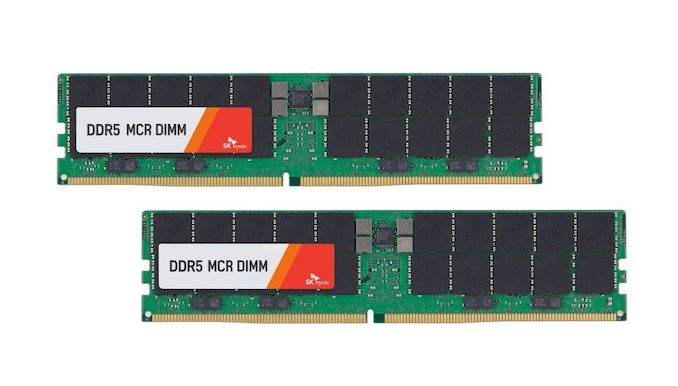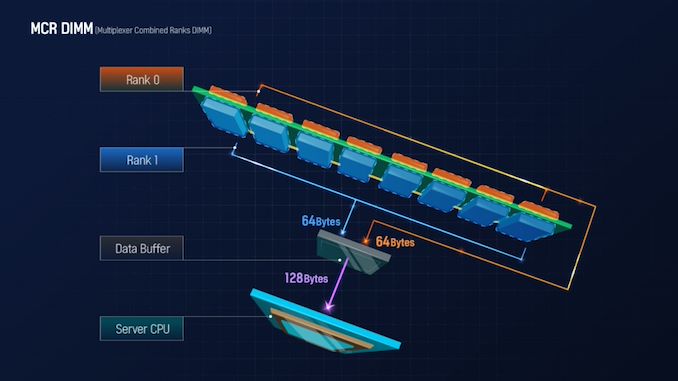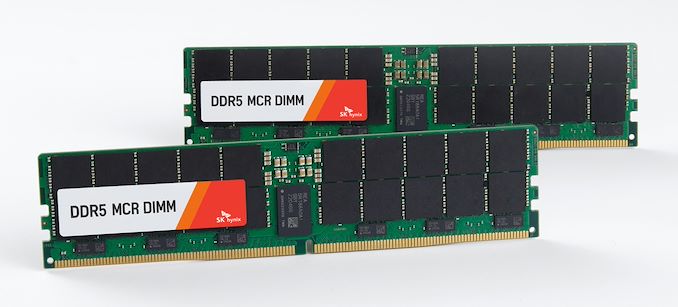SK hynix Reveals DDR5 MCR DIMM, Up to DDR5-8000 Speeds for HPC
by Gavin Bonshor on December 8, 2022 12:00 PM EST
One of the world's biggest semiconductors and manufacturers of DRAM, SK hynix, has unveiled it has working samples of a new generation of memory modules designed for HPC and servers. Dubbed Multiplexer Combined Ranks (MCR) DIMMs, the technology allows high-end server DIMMs to operate at a minimum data rate of 8 Gbps, which is an 80% uptick in bandwidth compared to existing DDR5 memory products (4.8 Gbps).
Typically, the most common way to ensure higher throughput performance on DIMMs is through ever increasing memory bus (and chip) clockspeeds. This strategy is not without its drawbacks, however, and aiming to find a more comprehensive way of doing this, SK hynix, in collaboration with both Intel and Renesas, has created the Multiplexer Combined Rank DDR5 DIMM.
Combining Intel's previously-unannounced MCR technology for its server chips and Renesas's expertise in buffer technology, SK hynix claims that their DDR5 MCR DIMM has 66% more bandwidth than conventional DDR5 DIMMs, with an impressive 8 Gbps/pin (DDR5-8000) of bandwidth. SK hynix themselves claim that the MCR DIMM will be 'at least' 80% faster than what's currently out there DDR5-wise, but it doesn't quantitate how it reaches this figure.
The technology behind the MCR DIMM is interesting, as it enables simultaneous usage of two ranks instead of one, in essence ganging up two sets/ranks of memory chips in order to double the effective bandwidth. Unfortunately, the details beyond this are slim and unclear – in particular, SK hynix claims that MCR "allows transmission of 128 bytes of data to CPU at once", but looking at the supplied DIMM photo, there doesn't seem to be nearly enough pins to support a physically wider memory bus.
More likely, SK hynix and Intel are serializing the memory operations for both ranks of memory inside a single DDR5 channel, allowing the two ranks to achieve a cumulative effective bandwidth of 8Gbps. This is supported by the use of the Renesas data buffer chip, which is shown to be on the DIMM in SK hynix's photos. Conceptually, this isn't too far removed from Load Reduced DIMMs (LRDIMMs), which employs a data buffer between the CPU and memory chips as well, though just how far is difficult to determine.
More curious, perhaps, is that this design puts a great deal of faith into the ability of the physical memory bus and host controller (CPU) to be able to operate at DDR5-8000 (and higher) speeds. Normally the bottleneck in getting more memory bandwidth in server-grade systems is the memory bus to begin with – having to operate at slower speeds to accommodate more memory – so going a route that requires such a fast memory bus is definitely a different approach. In either case, the ability to run DIMMs at DDR5-8000 speeds in a server would be a significant boon to memory bandwidth and throughput, as that's often in short supply with today's many-core chips.
As SK Hynix has partnered up with Intel via its MCR technology and using buffer technology from Renesas, MCR would seem to be an Intel-exclusive technology, at least to start with. As part of SK hynix's press release, Intel for its part stated that they "look forward to bringing this technology to future Intel Xeon processors and supporting standardization and multigenerational development efforts across the industry.” In the interim, this appears to be a technology still under active development, and SK hynix is not publishing anything about availability, compatibility, or pricing.
While SK Hynix hasn't gone too much into how MCR DIMM is twice as fast as conventional DDR5 memory, this product is designed for the high-performance computing (HPC) and server industries, and it's unlikely we'll see MCR DIMMs in any form on consumer-based systems. We expect to learn more in the not-too-distant future.
Source: SK Hynix












20 Comments
View All Comments
mode_13h - Monday, December 26, 2022 - link
> I doubt AMD and especially Intel will do on anything but their most expensive server CPUs.Competition is a wonderful thing. Once the Epyc or Xeon memory controller can support it, it should just be a configuration option that stands between enabling it on any model of server CPU. However, we're talking about CPUs that already support RDIMMs.
Oxford Guy - Friday, January 6, 2023 - link
Too bad people have been trained to believe that what barely qualifies as a duopoly is adequate competition.Foeketijn - Monday, January 2, 2023 - link
It doesn't cost any more traces, but those traces need to be able to handle a far higher frequency.mode_13h - Monday, December 26, 2022 - link
> so does the mobo need to support MCR DIMMsI think the issue is mainly that the CPU needs to support it. Its memory controller needs to be adapted to deal with a 128-byte minimum burst size.
deil - Friday, December 9, 2022 - link
And that's why we make those upgrades even when it seems bottlenecked. It's not even solid on the market, and someone is already ripping a chunk out of limits.Cache everything!
it seems like it might both double size and speed, which is never a bad thing, no matter what you do.
when and how much is now the main question. I hope its 2023 not 2032...
mode_13h - Monday, December 26, 2022 - link
It's probably even be too late for Turin (Zen5-based Epyc) and definitely too late for Emerald Rapids. Maybe Granite Rapids could support it.In other words, 2024 at the soonest. 2025, more likely.
Foeketijn - Monday, January 2, 2023 - link
Or never, when it cuts into the margins.mode_13h - Monday, January 2, 2023 - link
Well, look at the alternative: AMD's Genoa has reached 12 channels per CPU! It's not as if that 50% increase from the previous generation doesn't add costs.On consumer boards, we're already seeing people reach DDR5-7000 speeds and possibly higher. So, my expectation is that servers will indeed increase DDR5 speed, as a less expensive alternative to adding ever more channels. The only question is whether they'll use exotic techniques like MCR to do it.
Harry_Wild - Monday, December 12, 2022 - link
Just what I been waiting for in my next desktop Raptor Lake & Ryzen 7000 PCs. Need tip top memory performance for email, internet browsing and watching streaming videos/channels!mode_13h - Monday, December 26, 2022 - link
Allegedly, you can already buy DDR5-7800 for desktops. You don't need this.